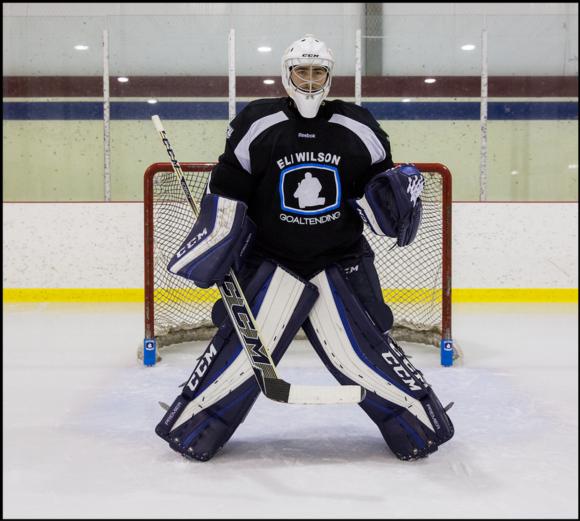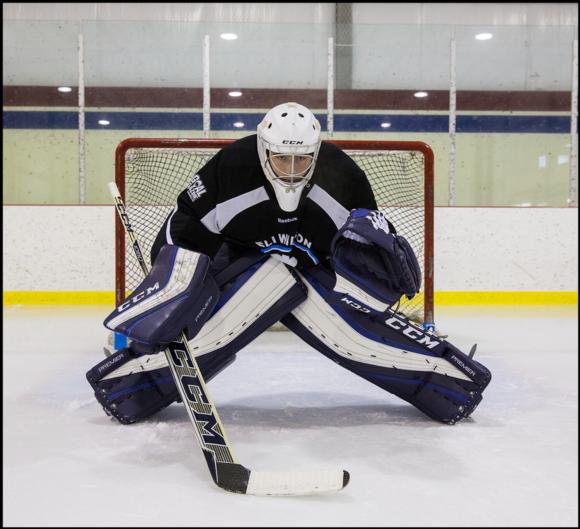The Tall Stance
The tall stance (figure 2.3) is used when the play does not pose an immediate threat. The goaltender stays in a more upright position than in the regular stance. The idea behind this stance is that you can conserve energy and at the same time have a greater field of vision. There are several instances when the tall stance is optimal:
- When you first leave the goal line to meet a rush, or when the puck is close to the walls or at the blue line so there is no immediate danger of a scoring opportunity.
- When you face a shorthanded situation, the play often stays in the zone for a long time. This stance allows you to regain composure as the puck moves back to the blue line.
- Any time there is a lot of traffic in front of the net.

Figure 2.3 The tall stance.
The main technical difference between the regular and tall stances is foot positioning. The goaltender places his feet shoulder-width apart in the tall stance, whereas in the regular stance, he places his feet slightly wider than shoulder width. By bringing the feet closer together, the goaltender can now straighten his body and bring his hips forward. The arms and gloves should not move. The goaltender’s stick will come up off the ice.
The key to utilizing the tall stance is that the goalie can get back into his regular stance in a split second. He must slightly push his feet to the outside, allowing them to go beyond shoulder width. He must then draw his hips back. The arms and gloves should already be set in the proper position. As the goaltender gets lower, his stick should be back on the ice in optimal position. Although the goaltender is not in an optimal ready position when using the tall stance, he is only a split second away from assuming that position. Here are a few more advantages of using the tall stance:
- You can easily stay square to the puck. In a tall and narrow position, you can be precise at lining up the middle of your body with the puck.
- A tall stance increases your mobility. If the opposition performs cross-ice D-to-D passes, you can follow the play by executing long, hard pushes. When the puck comes in tight, you are just a split second away from adjusting back to your regular stance and performing a butterfly movement.
- When in the tall stance, you have a greater field of view. You can track the puck by looking over and around players when there is a lot of traffic in front. In most circumstances, it is easier to watch the puck while standing up higher than it is from a low, crouched position. You must have the ability to quickly drop back into your regular stance and be able to go down to make the save.
The Low Stance
In contrast to the tall stance, the low stance (figure 2.4) is used for situations in tight to the goaltender, where he is required to bring his center of gravity down. To drop into the low stance, you must completely do the opposite of the tall stance by pushing your feet out into a wider position and bringing your hips back.

Figure 2.4 The low stance.
This will bring your body closer to the ice and thus put you in a position where you can react faster. Again, your arms and hands should not be moving. Your elbows should be kept close to your ribs, and you should be in full control of your forearms. Occasionally, you might have to push your arms slightly forward to adjust your upper body to the new, lower position. By doing so, you will be able to keep your arms close to your body, hips, and thighs.
When the play is in tight, the goaltender’s reaction time to make a save is greatly reduced. Following are some of the advantages of dropping into the low stance:
- Bringing your knees closer to the ice makes the transition to the butterfly position much quicker.
- Having your knees close to the ice when the play is in close is advantageous, as chances for a shot to the lower part of the net are very high.
- Although being in a wider stance decreases your power and mobility, the fact that the play is in tight means you will be deeper in your crease. If you must move, your pushes will not need to be as long as when you are at the top of your crease, so you can still get across to make the save.
Save